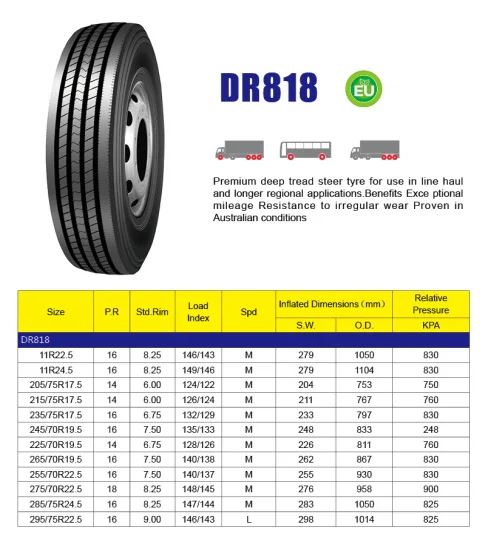Your tires form the essential bond between your vehicle and the ground. The tread grips the road as you drive. But if it's not deep enough, your car loses traction and suffers extended braking times. Shallow tread grooves make it harder to control the vehicle in wet weather and the chance of aquaplaning increases. To ensure your safety, measure the tread depth as part of your regular vehicle maintenance.
Tread is the rubber on the tire that touches the road. New tires have an average tread depth of 8 to 9 millimeters (10/32 to 11/32 inches). As you drive, the tread will wear down. A tire with a tread depth below 1.6 millimeters (2/32 inches) lacks grip. Braking distance and vehicle control are impaired. These tires are not safe for driving and must be replaced.
Please consider that safe driving in wet and snowy weather conditions is affected by the tread depth, the pattern design and the rubber compound of the tread of your tires. On wet or snow-covered roads braking performance will progressively decline with lower tread depths. On wet roads there is an additional increased risk of aquaplaning with fading tread depths.
Therefore, check your tires regularly, reduce your speed on wet and snowy roads and consider replacing your tires in good time.
Ensure your vehicle is equipped with the correct winter, summer, or all-season tires.
Tread wear indicators, or wear bars, are spaced evenly through the main grooves in the tire tread. If they are flush with the level of the tread, then the tire should be replaced.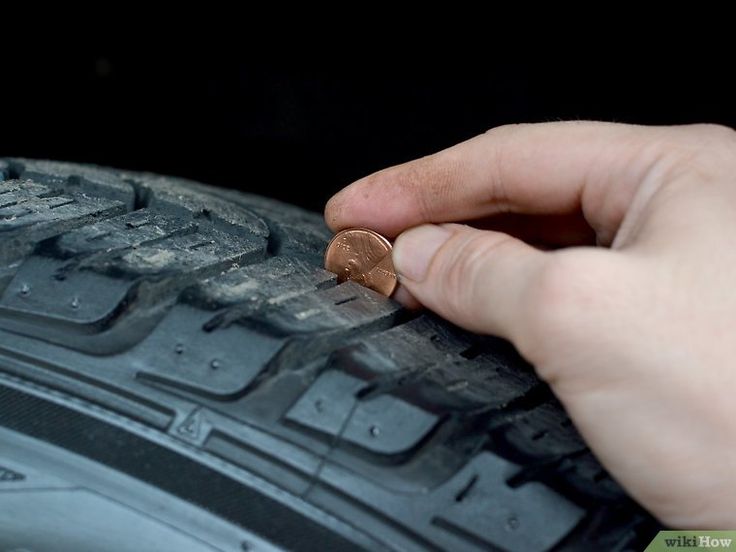
Several winter tire models are equipped with winter tire wear indicators. If they are flush with the level of the tread, the tire is no longer suitable for winter driving conditions. In some locations, they may also no longer legally qualify as winter tires.
The tire tread grips the road and wears down as you drive. To ensure your safety, measure the tread depth as part of your regular vehicle maintenance.
If you have a tire tread depth gauge, use it to measure the tread depth. Insert the probe bar into the groove and push the shoulders flush with the tread. Check the top of the gauge to see the measurement. Alternately, a small ruler can be used.
Be sure to check in various locations. A misaligned wheel may result in uneven treadwear. Keep an eye open for any areas that look more worn than the surrounding surface. The tire's tread should be judged by the lowest depth you measured.
If you are uncertain of the measurements, take your vehicle to a service center.
While measuring the tread, look for cupping, or scalloping. These are small scoops, or divots, carved from the tread. They can indicate misalignment or other problems with your vehicle. Take your car to a service center.
Also, watch out for bulges in the tire tread or sidewall. They are not safe. You need to get a new tire.
When it comes to checking tire tread, there are a number of methods that can help you know if it’s time to replace a tire. Heavily worn tread will prevent a tire from performing as designed and can lead to unsafe driving conditions. One of the simplest, most common ways to check tread depth requires nothing more than a penny and a few moments of your time.
In the United States, tire tread depth is measured in 32nds of an inch. New tires typically come with 10/32” or 11/32” tread depths, and some truck, SUV and winter tires may have deeper tread depths than other models.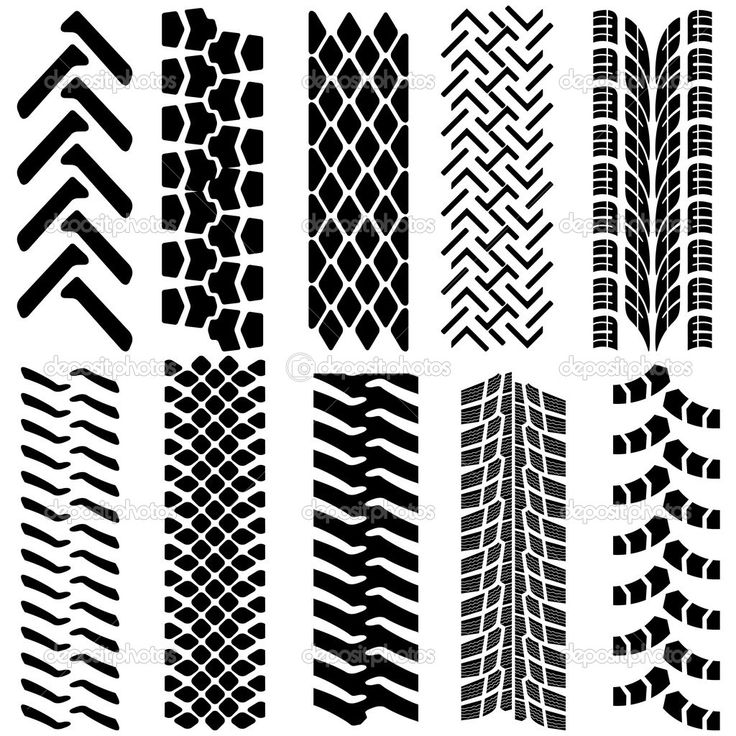 The U.S. Department of Transportation recommends replacing tires when they reach 2/32”, and many states legally require tires to be replaced at this depth.
The U.S. Department of Transportation recommends replacing tires when they reach 2/32”, and many states legally require tires to be replaced at this depth.
The idea of the penny test is to check whether you’ve hit the 2/32” threshold. Here’s how it works:
Place a penny between the tread ribs on your tire. A “rib” refers to the raised portion of tread that spans the circumference of your tire. Tire tread is composed of several ribs.
Turn the penny so that Lincoln’s head points down into the tread.
See if the top of his head disappears between the ribs. If it does, your tread is still above 2/32” , If you can see his entire head, it may be time to replace the tire because your tread is no longer deep enough.
When performing the penny tire test, remember not only to check each tire, but to check various places around each tire. Pay special attention to areas that look the most worn. Even if parts of your tread are deeper than 2/32”, you should still replace the tire when any areas fail the penny test.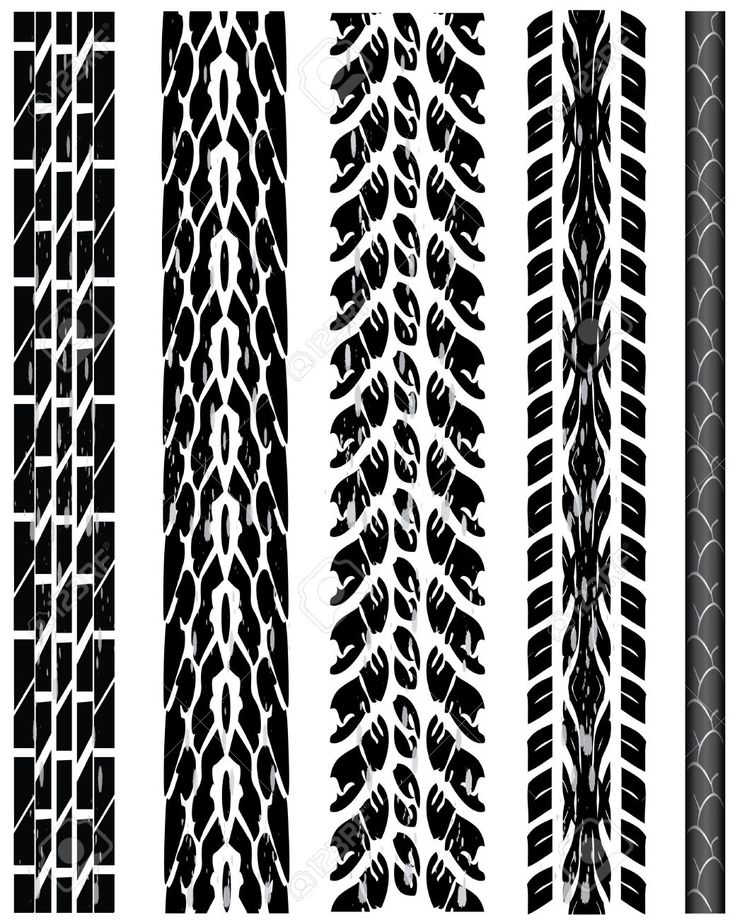
Consistent wear around the whole tire is normal, but uneven tread wear could be a sign of improper inflation, wheel misalignment, or a variety of other things. If you see uneven tread wear, you should have a technician inspect your vehicle.
A simple way to check your tire tread depth is by using a tread depth gauge. You can find tire tread depth gauges at your local auto parts store. There are many models available, but an inexpensive simple graduated probe gauge will work just fine. All you have to do is stick the probe into a groove in the tread and press the shoulders of the probe flat against the tread block and read the result. All gauges should measure in both 32nds of an inch and millimeters.
Another indicator of worn out tread already lives in your tires themselves. Every performance, light truck, or medium commercial tire comes equipped with indicator bars (or wear bars) embedded between the tread ribs at 2/32”.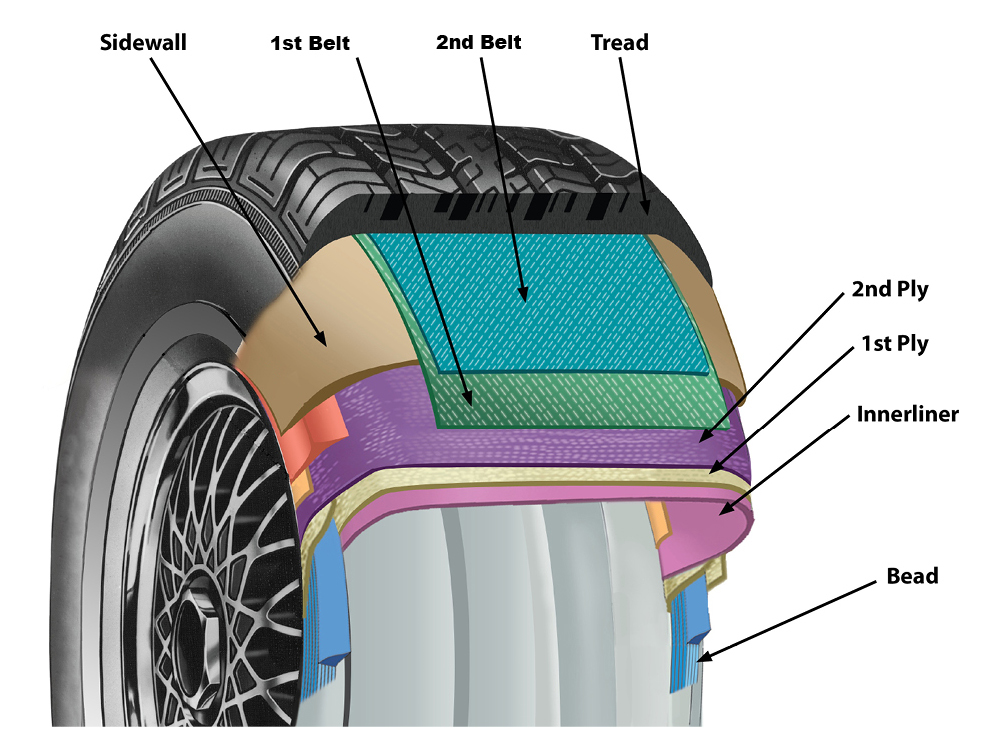 They’re there to help you monitor tread depth and make decisions about tire replacement. Just look to see if the tread is flush with the indicator bars. If they are, it’s time to replace the tire.
They’re there to help you monitor tread depth and make decisions about tire replacement. Just look to see if the tread is flush with the indicator bars. If they are, it’s time to replace the tire.
While the penny tire test does deliver on what it promises – indicating whether tread has reached the legal limit – it may not be the best indicator of whether your tires are safe for the road. Tire performance can diminish significantly before your tread hits 2/32”. Even though the law deems fit for safe driving may not prevent you from hydroplaning or losing control in rainy, slushy conditions. If you think your tires may be close to needing replacement, have them checked out by a licensed mechanic.
Tire is the most important structural element of the vehicle, on which the driver's safety on the road will depend. It guarantees reliable traction and, depending on the type of tire, can be used in different weather conditions on different roads.
The outer layer of the wheel that comes into contact with the road and makes contact with the belt is the tread. It has a three-dimensional structure and grooves in different directions, depending on the purpose of the tire, different depths.
The tread is necessary for the most reliable grip of the car with the road, for the removal of water, dirt, snow and other substances from the points of contact between the tire and the road.
Depending on how worn, how effective the tread is, the characteristics of the tire will vary:
You need to know that the quality of braking will also depend on the state of the tread on the tires.
Interesting : in addition to the fact that the tread acts as a "trap" of snow and water from under the wheel, it also reduces the likelihood of aquaplaning, providing additional safety.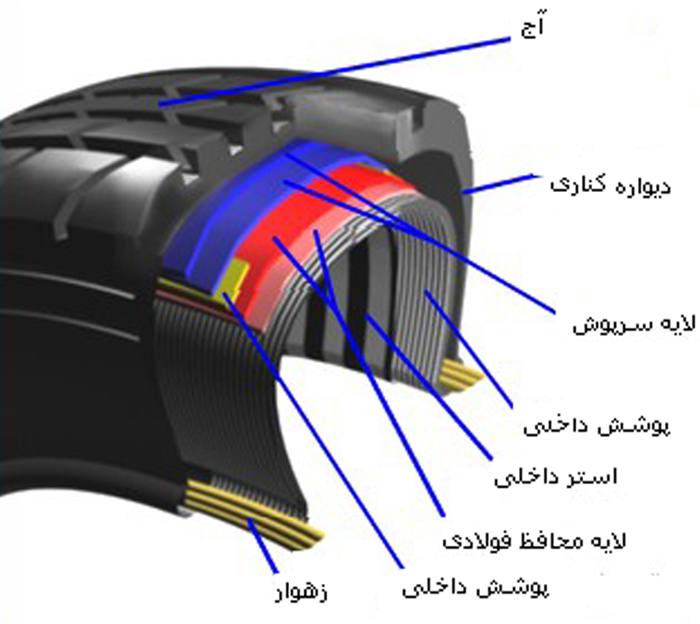 There are tread height standards that are measured by special indicators on the tire that are applied at the factory. If it is worn deeper than the indicator, the tire must be changed urgently.
There are tread height standards that are measured by special indicators on the tire that are applied at the factory. If it is worn deeper than the indicator, the tire must be changed urgently.
How does the tread affect the car's handling?
The more kilometers you drive, the more the tires wear, reducing the stability of the car on the road.
To reduce the braking distance, tire manufacturers make a special pattern and tread depth on the tire. With tire wear, the likelihood of hydroplaning on wet pavement increases significantly: the rear and front wheels start spinning at different speeds, as a result of which the car begins to skid on the wet road surface. It is almost impossible to drive a car in such a skid.
A worn tire can make it difficult to drive in bad weather, increase stopping distance on any surface, and reduce braking performance by reducing the weight of the wheels.
Worn-out tires are dangerous not only in bad weather, but also on a dry, level track.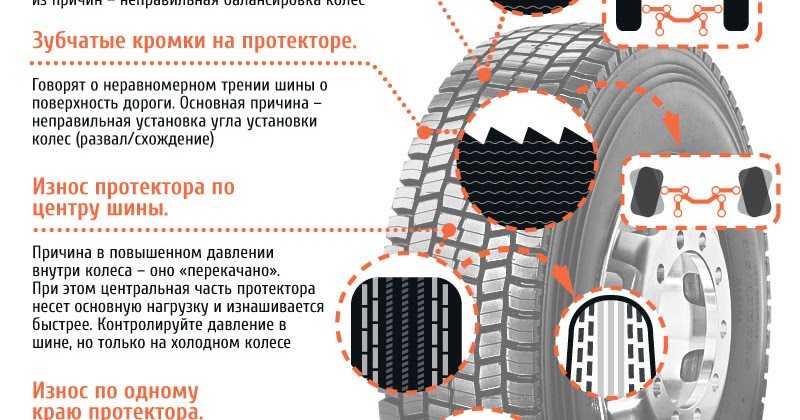 They reduce the stability of the car, especially on older cars without EPS.
They reduce the stability of the car, especially on older cars without EPS.
Winter tires are a separate story. The structure of each tire is carefully thought out by the manufacturers, therefore it effectively removes snow masses and dirt from under the car wheels, where the car comes into contact with the road. The rubber composition is also important, which will be unique for winter models - with special additives against rubber “tanning” in the cold.
How do I find out my tread size?
In order not to endanger yourself, you need to check the tread depth on your rubber at regular intervals. There are several ways to measure a car tread that can be done without special equipment.
First of all, almost all modern tires have wear indicators from the manufacturer. They are in recesses and are presented in the form of a membrane or bulge. If the rubber wears to a minimum level, then the indicator goes on the same level with the tread - this is a signal that it is time to change the rubber or make it regrooving tread on an existing tire, if the thickness of the rubber allows (all about treading in in a separate article ).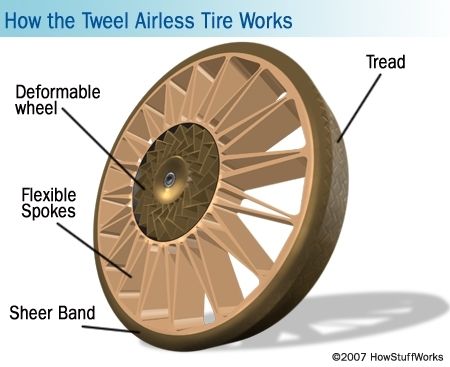
On truck tires, however, it is quite popular to weld on a new tread, provided that the cord is intact. Read more about hardfacing here .
Sometimes manufacturers create rubber in several multi-colored layers, upon reaching one of which it will be necessary to change tires. For accurate measurement, you need to use a special depth gauge or caliper. Measurements are carried out over the entire circumference and width of the tire to assess the uniformity of wear, and identify the need for camber and convergence of the wheels.
If, in the process of measuring the tread, you find damage to the rubber, a broken cord or cuts in the tread, you need to go to a tire fitting or change tires, since any defect can suddenly provoke a dangerous accident on the road. If it is not possible to replace all 4 tires at once, it is better to put new tires on the drive axle. In this case, change the tires on each axle in pairs, and not one at a time, which will not impair the vehicle's handling.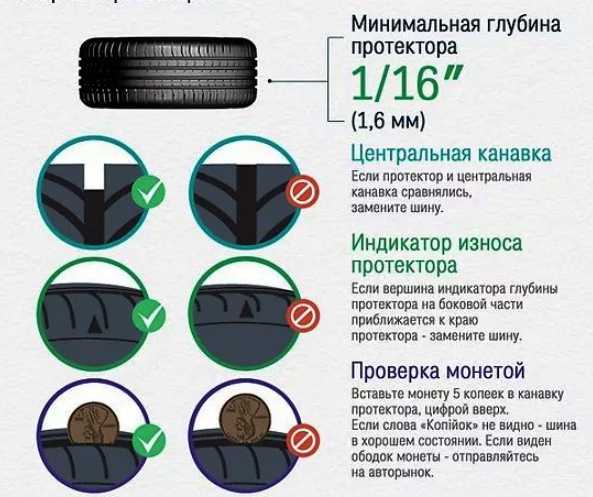
At what tread depth should I change?
If there are no indicators or multi-color layers in the tire, then you need to know the values \u200b\u200bof the minimum tread depth for self-measurement:
For winter tires, the minimum depth must be at least 4 mm. Such tires are used for driving on snow and ice and are marked with the English "M" and "S" and a snowflake. These tires have deeper sipes and grooves, so it achieves a firmer grip.
How to choose new tires?
When buying tires for your car, there are many factors to consider, such as road conditions, weather conditions, frequency of use, and tire manufacturer. You also need to know the nature of the trips (in the city, intercity, off-road), which will allow you to find an option for your own needs.
For example, an off-road vehicle must be equipped with high-strength tires that are not subject to rapid wear and mechanical damage. Such tires should have a deep tread, which guarantees excellent handling and off-road capability of the vehicle.
Maksishyna's specialists recommend buying tires equipped with wear indicators, which will allow you to determine the degree of wear at any time, rather than "tinkering" with calipers and other devices.
How to choose the pattern and depth of rubber?
The pattern of a tire is extremely important in its operation. For example, the non-directional tread is more commonly used because of its versatility. These are good quality tires that can be mounted on either side without having a direction of rotation. Such tires guarantee stable stability of the car at speed and are inexpensive with high versatility.
In addition, there are tires with asymmetric patterns. The outer part of the tread guarantees excellent grip on asphalt and other types of roads. Most often, asymmetric tires are installed by those who drive a lot off-road.
Most often, asymmetric tires are installed by those who drive a lot off-road.
The directional tread pattern reliably protects the driver from aquaplaning, is excellent for driving on asphalt, shows good performance on ice. The protector sets the direction of rotation of the wheels, and should only be placed on the axis and side assigned to it. Difficulties with these wheels arise when it is necessary to install a spare tire, which must be selected of the same type as the tire being replaced, otherwise the quality and reliability of driving will be impaired.
Is it possible to put tires on a car with different tread?
It is best to buy 4 identical wheels and install them at the same time. If you need to replace one of the wheels, try to find the same tire. Tires from different manufacturers of different types on the same axle are strictly prohibited. It is also important that when changing tires from summer to winter and vice versa, 4 wheels must be changed at the same time. By the way, worn tires are best to be recycled. Find out more about tire recycling here .
By the way, worn tires are best to be recycled. Find out more about tire recycling here .
If the size of the protector does not meet the norm, they cannot be used - this is unsafe for the life and health of participants in the DD. Note that the standards do not apply to tires with special wear indicators.
Adhere to the norms for the tread depth on your tires, banal and elementary driving rules, and you will be provided with a comfortable, safe ride.
The tire tread is the outer part of the wheel that provides traction in all weather conditions. The protectors inevitably wear out during the operation of the car, the working height of the slope decreases. The residual tread depth should be periodically monitored and the set of tires should be renewed in time - this will reduce the risk of losing control of the car and save the car owner from fines from the traffic police.
Tread wear rate depends on many factors:
Measuring the thickness of the tread layer will allow you to accurately determine the degree of tire wear and make a decision in time to replace them with new ones.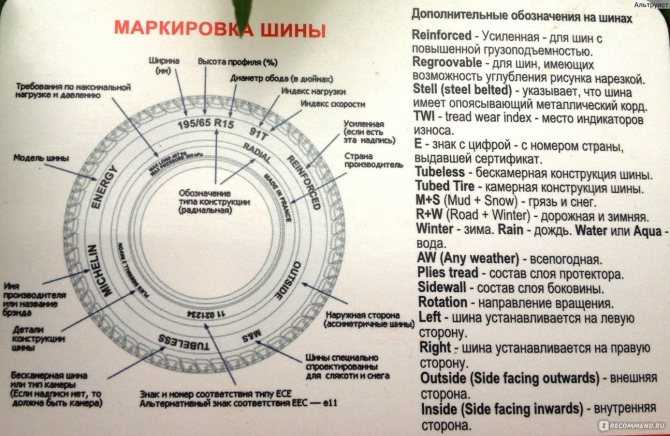
Different tires have different wear limits. Tread depth affects vehicle handling and road safety.
| According to Chapter 5 of the SDA, limiting norms for the height of the tread pattern have been established. For category M1 - passenger cars - as well as vehicles of categories N1, O1 and O2, the minimum allowable value is 1.6 mm. When using winter tires on snowy or icy surfaces - the limit is 4 mm. |
Let us explain what categories of vehicles we are talking about:
N1 - vehicles intended for the carriage of goods, having a technically permissible maximum mass of not more than 3.5 tons;
O1 - trailers, the technically permissible maximum mass of which is not more than 0.75 tons;
O2 - trailers, the technically permissible maximum weight of which is over 0.75 tons, but not more than 3.5 tons.
The traffic police officer has the right to measure the residual depth with a verified device. In case of a recorded violation, a fine is imposed on the car owner.
The new summer tire has an average tread depth of 7-8 mm. The service life of summer tires is usually 3-5 seasons with average mileage and moderate driving style.
| Residual height limitation by law is 1.6 mm. However, with a remaining outer layer of 3 mm, the machine is already difficult to control, grip deteriorates, and a safety hazard arises. |
Do not wait until the critical value is reached. Make sure you change tires in advance.
Winter tires are used in severe weather conditions: low temperatures, icy conditions, on snowy road surfaces. Worn elements make the tire ineffective on slippery winter roads. Accordingly, a more serious approach to the condition of the tire tread is needed.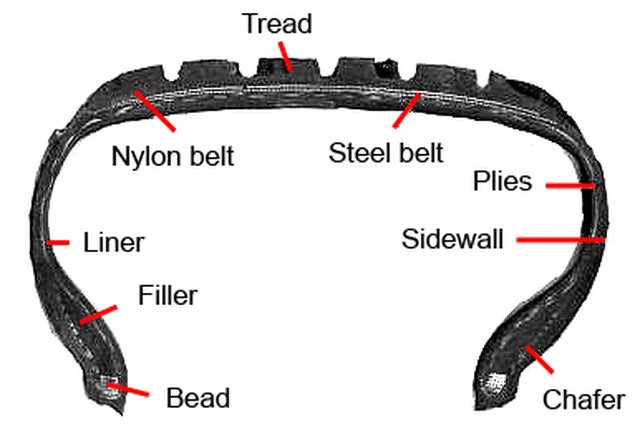
Non-studded friction tire (Velcro) with a tread depth of 8-9mm. A new studded model - from 9 to 11 mm, some firms produce a tread with a height of 12-18 mm.
| If the tread wear is up to 4-5 mm, the winter set of tires needs to be replaced. In addition, the loss of more than 50% of the metal spikes is also a reason to change the car's shoes. |
The average life of winter tires is 2-4 years.
Universal all-weather is used in a temperate climate both in winter and in summer, it is optimal at temperatures from +10 to -10˚C. This type of tire is not suitable for use in snowfall or severe frosts. SDA allows the use of all-season tires in the winter if there is a special marking:
| All-season tires last 3-4 years on average. In summer, at high temperatures, all-weather tires wear out much faster. |
You can estimate the remaining tread layer in various ways:
On some tire models there are special volumetric indicators in the form of jumpers. Check: if the tread layer is worn down to the level of the jumpers, the tire is not suitable for further use.
On the surface of certain types of tires, manufacturers knock out numbers of various depths. Depreciation is assessed visually - by the visibility of individual numbers.
With the help of measuring instruments: from a metal ruler, caliper, depth gauge to an electronic tread depth gauge.
Many motorists measure the remaining tread depth with a coin. Warning: this method of measurement is not accurate. It will not show you actual tire wear figures.
Tire tread height should be measured at least at 6 different points, preferably at 9 or even 12: in the center and from both edges of the tread, at different points around the circumference of the tire. The measurement results at all specified points must match. If they do not match, then the tire wears unevenly. The driver should find out why this is happening. Some causes of uneven tire wear are low or high pressure in them relative to the regular one, suspension failure, extreme driving style.
The measurement results at all specified points must match. If they do not match, then the tire wears unevenly. The driver should find out why this is happening. Some causes of uneven tire wear are low or high pressure in them relative to the regular one, suspension failure, extreme driving style.
Old tires have become unusable, the amount of tread remaining is approaching a critical line - no need to take risks, it's time to change your car's shoes. There is a great temptation to get by with small financial costs and purchase a set of used tires. Be careful!
Sellers advertise used tires in good or excellent condition. Do not be too lazy to personally measure the height of the tread layer. And remember: for winter tires, a residual tread depth of 4 mm is already 100% wear.
When buying used tires with tires, it is important to remember that tires of different manufacturers and seasonality initially have different tread heights (when they are new). And most importantly: the tires have, accordingly, different wear limits - the tread depth at which the tire begins to lose important characteristics. These differences are most noticeable in winter and summer tires. Keep these points in mind when measuring the remaining tread depth of used tires.
These differences are most noticeable in winter and summer tires. Keep these points in mind when measuring the remaining tread depth of used tires.
The quality of domestic roads, unfortunately, does not allow tires to be used for 7–10 years. If you still decide to buy a used kit, check the year of manufacture - it is better not to consider tires older than 8 years.
there is no guarantee for tires bought from hands;
the seller can cheat - for example, offer tires from different manufacturers in one set. Some especially enterprising salesmen even cut the tread on the worn rubber, as if the tires had not yet worn out;
you will have to spend a lot of time picking up tires from private sellers - much of what is put up for sale is only suitable for recycling;
Products may have hidden or visible defects. Visible are punctures, tears, cuts. A tire with a lot of damage can collapse in motion.